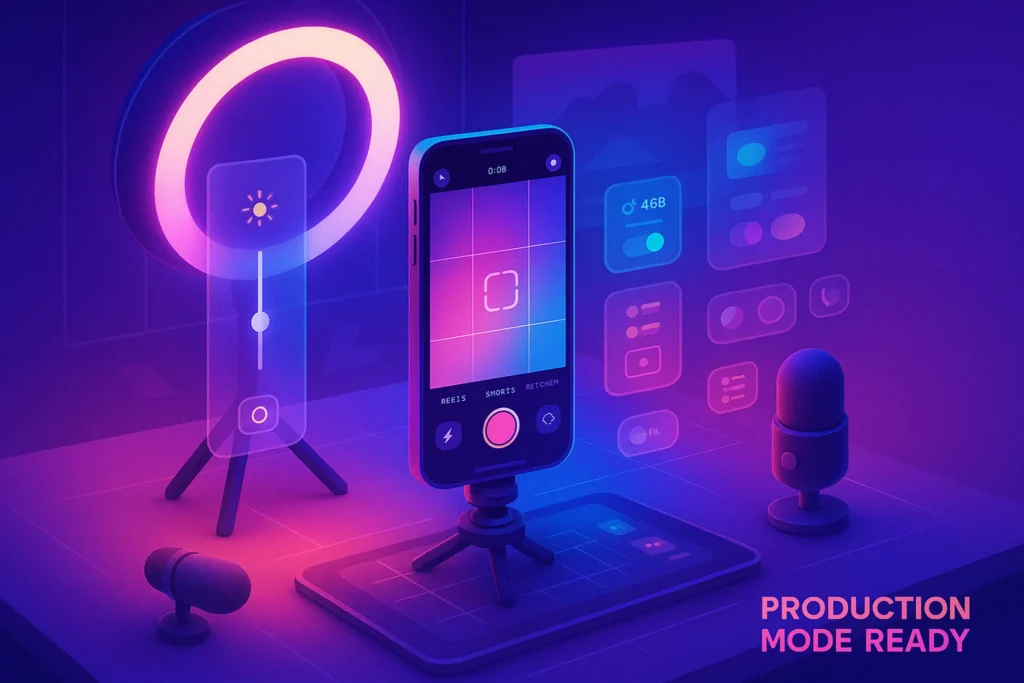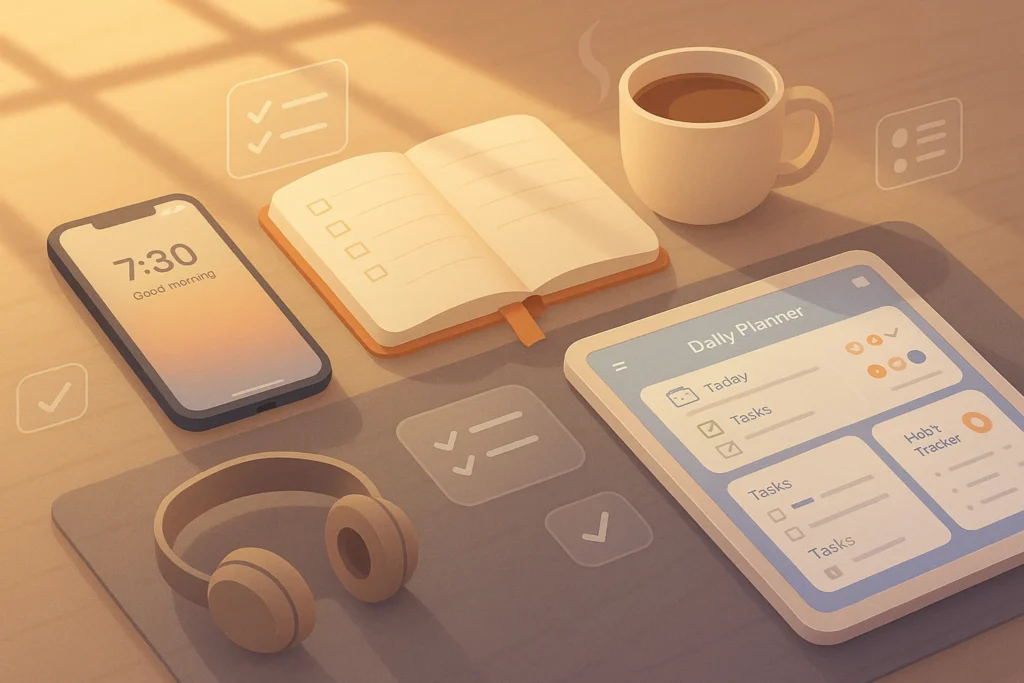🧱 Introduction
You don’t need a DSLR or mirrorless setup to take jaw-dropping photos for your content. In fact, if you’re holding a smartphone built after 2020, you’re already carrying a photography powerhouse. But here’s the catch: having a great tool is only part of the equation. To truly stand out on Reels, Shorts, or even YouTube Thumbnails, you need more than pixels—you need composition mastery, creative framing, and the right gear hacks.
In this guide, we’ll break down the exact strategies, tools, and visual frameworks you need to elevate your smartphone photography game from “decent” to “scroll-stopping.” Whether you’re shooting behind-the-scenes moments, crisp product shots, or face-forward storytelling clips, you’ll walk away ready to create like a pro—with just your phone and a few powerful tricks.
📷 Why Mobile Photography Matters in 2025
Let’s face it—mobile content now drives the majority of digital interaction. If your visuals don’t immediately captivate, you’re out of the feed in seconds. High-quality smartphone visuals boost engagement, increase retention time, and help you build visual credibility as a creator or brand.
With platforms like Instagram Reels, YouTube Shorts, and TikTok optimizing for vertical, high-resolution, and authentic-looking content, learning to master your phone camera isn’t just optional—it’s a competitive necessity.
In fact, many creators today build entire content libraries using just their smartphones, assisted by affordable gear and AI-powered post-editing apps. You don’t need expensive film-school setups—you need technique, strategy, and precision.
If you’re also interested in maximizing what your phone camera can already do, check out our deep dive into Using Your Smartphone Camera to Its Full Potential, where we unpack native settings, grid overlays, and raw shooting hacks.
💡 Lighting: Your Invisible Superpower
Lighting is the single most underrated aspect of mobile photography.
Most smartphone sensors struggle in low light or with uneven shadows. Natural light is your friend—early morning or golden hour light often gives the most flattering results. But when indoors or under control, investing in compact LED panels or clip-on lighting rigs can instantly elevate your visual game.
Here’s how to level up your lighting:
-
Ring Lights for face-front videos or product demos.
-
Portable RGB Panels for creative tone and background mood.
-
Clip-on Fill Lights for eliminating harsh shadows.
Pairing this with a solid mobile tripod or flexible mount helps you position lighting with precision—essential for product showcases, tutorials, or clean portrait setups.
Smartphone photographers who build mini content studios also benefit from tools like diffusers, reflectors, and warm-tone LEDs—all of which can be stored in a small creator bag.
🎯 Composition Techniques That Hook Viewers (Especially for Reels, Shorts & Thumbnails)
Smartphone cameras are great—but without strong composition, your visuals can still feel amateur. Good framing and positioning are what transform a casual shot into a visually compelling piece that drives clicks, likes, and watch-time.
Here are some essential techniques, especially tailored for content creators making short-form videos or thumbnails:
1. The Rule of Thirds
Use your phone’s grid feature to align key elements at the intersections. This creates balance and guides the viewer’s eye toward what matters most—your face, your product, or your call to action.
2. Leading Lines
Framing your subject with lines (like doorways, desk edges, window frames) naturally draws attention. This is especially powerful for thumbnails or explainer-style content.
3. Foreground Interest
Adding layers (like a blurred coffee mug, tech gear, or plants in front) adds depth. It makes your setup look cinematic and professional, even with a mobile lens.
4. Eye-Level Framing
For engagement-driven content (like speaking to the camera), hold the phone at your natural eye level, not from above or below. It feels more human and authentic.
5. Negative Space
Don’t be afraid of empty background—it lets text overlays, titles, and Reels captions breathe.
If you want a breakdown of how to apply these composition tactics in graphic design too, don’t miss our guide on Designing Infographics That Actually Convert. The visual thinking principles overlap beautifully with mobile photography.
💡 Nerd Tip: Before you shoot, pause and ask: “What do I want the viewer to feel or focus on in this frame?”
📸 Want More Creator Gear Tips & Mobile Shooting Guides?
Subscribe to our free weekly newsletter for content creators. We share gear reviews, mobile photography techniques, and short-form video tips—curated for busy creators who want pro results on the go.
🔒 No spam. Just fresh strategies, tech tutorials, and visual hacks straight from NerdChips.
🎙️ External Audio Tools That Instantly Boost Production Value
Poor sound = instant swipe. No matter how good your lighting or framing is, if your audience can’t hear you clearly, they won’t stick around.
Here’s how to make sure your audio is on point—even when using a phone:
-
Lavalier Microphones (like Rode SmartLav+) clip onto your shirt and record clean vocals directly into your phone.
-
Wireless Mics (like DJI Mic or Hollyland Lark M1) give you more mobility without losing clarity.
-
Shotgun Mics (like Shure MV88) are ideal for vlog-style or narrative content.
Bonus tip: Use AI-powered tools like Krisp or Descript Studio Sound to remove background noise and normalize audio levels during editing. You can also check our list of Top Content Creation Tools for Social Media for more post-production options.
🧰 Creator Gear: Tripods, Lenses, and Rigs That Make a Difference
Once you’ve nailed light, sound, and composition—gear comes in to stabilize, extend, and stylize your shots. Here’s what every serious smartphone content creator should consider:
-
Flexible tripods (like Joby GripTight) for vlogging, top-down shots, and time-lapses.
-
Clip-on lenses (like Moment or Apexel) to simulate wide-angle, macro, or cinematic effects.
-
Gimbals (like DJI Osmo Mobile) for buttery smooth motion shots, especially on the move.
-
Phone cages (like SmallRig Mobile Rig) let you attach mics, lights, and handles all at once.
Not sure which setup suits your style? Our breakdown in Best Smartphone Accessories for Content Creators can guide your gear decisions based on use case and budget.
🧾 Format Variation: Composition Cheat Sheet for Reels & Thumbnails
To save time and lock in pro results, here’s a practical cheat sheet you can use when shooting with your phone. Print it, screenshot it, or turn it into a tap-to-open Shortcut in your phone gallery.
| Scenario | Frame Type | Key Tip | Lighting |
|---|---|---|---|
| Talking-Head Reels | Eye-Level, Medium | Rule of Thirds + Catch Light in Eye | Natural window + fill light |
| Product Demo (Hands) | Top-Down | Neutral background, consistent hand angle | LED Panel from side |
| Reaction Shorts | Selfie Mode | Facial expression centered, clean background | Ring Light on face |
| Tutorial B-Roll | Close-Up | Use Macro lens, show movement clearly | Side light or diffused |
| YouTube Thumbnail | Wide or close mix | One expressive pose + clean negative space | Bright daylight or LED |
🎯 Nerd Tip: Keep a reusable background (white paper roll or soft texture cloth) for clean and consistent shots.
🧠 Smart Techniques for Social Optimization
Even the best-looking photos won’t perform if they aren’t platform-optimized.
Here’s how to prep for each content platform:
-
Instagram Reels: Shoot in 9:16, leave top and bottom 15% clear for text overlays. Boost contrast slightly in post.
-
YouTube Shorts: Prioritize central framing. Add manual subtitles in apps like CapCut or Captions.ai.
-
Pinterest Idea Pins: Use vertical layout with bold, bright backgrounds and overlaid text headers.
-
Thumbnails (YouTube): Take a second clean shot just for thumbnail—zoomed in, exaggerated emotion, and bold facial expression.
Many creators streamline their workflow with collaborative idea boards or AI Tools for Brainstorming. These can help you pre-plan content themes, color palettes, or even trending shot styles before hitting record.
🖼️ Before & After Coaching: How Small Tweaks Make Big Impact
Sometimes, the difference between meh and wow in smartphone photography comes down to just a few changes in light, angle, or background. Here are a couple of real-world micro case studies to illustrate what we mean:
📷 Example 1 – Talking to Camera
-
❌ Before: Harsh sunlight behind subject, face in shadow, busy background with laundry rack
-
✅ After: Moved 90°, used natural side light from a window, removed background clutter → face lit evenly, clean vibe, ready for Reels
📷 Example 2 – Product Demo Shot
-
❌ Before: Hand holding item in kitchen, yellow ambient lighting, noisy counter surface
-
✅ After: Placed item on white sheet by window, added fill light and shot top-down → product pops with clarity, ready for IG carousel
🎯 Takeaway: Always scan your frame before shooting. One small adjustment in angle or light often yields pro-level results—even with the same phone.
📋 Content Workflow Template: 5 Steps Before You Hit Record
High-quality smartphone content doesn’t come from winging it—it comes from prepping with intention. Here’s a repeatable 5-step mini-workflow you can use before every photo or video session:
-
Frame Your Space
Clear clutter, check background symmetry, test natural vs artificial light. -
Enable Grid & Lock Exposure
Activate the rule-of-thirds grid. On iPhones or advanced Androids, long-press to lock focus & exposure. -
Plug in Audio Gear + Mic Test
Always test your lav or shotgun mic with a quick “test test 1-2” and replay it. -
Storyboard Mentally (3 Points Max)
Decide what your A–B–C story is (Hook, Value, Call-to-action). Don’t overcomplicate. -
Shoot Multiple Takes Intentionally
Take one wide, one medium, and one tight shot—this helps in editing and repurposing.
📌 This is the same micro-workflow many pro creators use when batch recording content for multiple platforms. Simplicity = consistency.
🧠 The Psychology Behind Good Framing
Visuals aren’t just about aesthetics—they communicate emotion and authority on a subconscious level.
-
Eye-level shots: foster connection. Your audience feels like you’re an equal, not above or below them.
-
Balanced composition: suggests professionalism and stability. It reduces cognitive load and makes the viewer focus on the subject (you or your product).
-
Negative space: gives the impression of clarity and purpose. It’s not empty—it’s intentional breathing room.
People may not notice these principles outright, but they feel them. Great visual framing builds silent trust—image by image, frame by frame.
🧠 Nerd Verdict
Smartphone photography isn’t just a workaround—it’s a full creative discipline.
With the right gear, composition techniques, and platform-specific tweaks, your phone becomes a studio in your pocket. For content creators aiming to build a consistent visual brand, convert attention into engagement, and grow an audience—mastering smartphone photography is a high-ROI investment of time and creativity.
Just remember: content quality comes from intent, not just tools. Start with a goal, apply a visual strategy, and let your phone do the rest.
❓ FAQ: Nerds Ask, We Answer
💬 Would You Bite?
📸 What’s the most valuable smartphone photography tip you’ve learned so far?
Or—have you ever captured a viral shot using just your phone?
Drop your insight or share a pic in the comments. Let’s build better content—together. 👇



